I'm trying to follow this as an example but can't seem to adapt it to work with my dataset since I need truncated normals: https://stackoverflow.com/questions/35990467/fit-two-gaussians-to-a-histogram-from-one-set-of-data-python#=
I have a dataset that is definitely a mixture of 2 truncated normals. The minimum value in the domain is 0 and the maximum is 1. I want to create an object that I can fit to optimize the parameters and get the likelihood of a sequence of numbers being drawn from that distribution. One option may be to just use the KDE model and using the pdf to get the likelihood. However, I want the exact mean and standard deviations of the 2 distributions. I guess I could, split the data in half and then model the 2 normals separately but I also want to learn how to use optimize in SciPy. I'm just starting to experiment with this type of statistical analysis so my apologies if this seems naive.
I'm not sure how to get a pdf this way that can integrate to 1 and have a domain constrained between 0 and 1.
import requests
from ast import literal_eval
from scipy import optimize, stats
import matplotlib.pyplot as plt
import seaborn as sns
import numpy as np
# Actual Data
u = np.asarray(literal_eval(requests.get("https://pastebin.com/raw/hP5VJ9vr").text))
# u.size ==> 6000
u.min(), u.max()
# (1.3628525454666037e-08, 0.99973136607553781)
# Distribution
with plt.style.context("seaborn-white"):
fig, ax = plt.subplots()
sns.kdeplot(u, color="black", ax=ax)
ax.axvline(0, linestyle=":", color="red")
ax.axvline(1, linestyle=":", color="red")
kde = stats.gaussian_kde(u)
# KDE Model
def truncated_gaussian_lower(x,mu,sigma,A):
return np.clip(A*np.exp(-(x-mu)**2/2/sigma**2), a_min=0, a_max=None)
def truncated_gaussian_upper(x,mu,sigma,A):
return np.clip(A*np.exp(-(x-mu)**2/2/sigma**2), a_min=None, a_max=1)
def mixture_model(x,mu1,sigma1,A1,mu2,sigma2,A2):
return truncated_gaussian_lower(x,mu1,sigma1,A1) + truncated_gaussian_upper(x,mu2,sigma2,A2)
kde = stats.gaussian_kde(u)
# Estimates: mu sigma A
estimates= [0.1, 1, 3,
0.9, 1, 1]
params,cov= optimize.curve_fit(mixture_model,u,kde.pdf(u),estimates )
# ---------------------------------------------------------------------------
# RuntimeError Traceback (most recent call last)
# <ipython-input-265-b2efb2ca0e0a> in <module>()
# 32 estimates= [0.1, 1, 3,
# 33 0.9, 1, 1]
# ---> 34 params,cov= optimize.curve_fit(mixture_model,u,kde.pdf(u),estimates )
# /Users/mu/anaconda/lib/python3.6/site-packages/scipy/optimize/minpack.py in curve_fit(f, xdata, ydata, p0, sigma, absolute_sigma, check_finite, bounds, method, jac, **kwargs)
# 738 cost = np.sum(infodict['fvec'] ** 2)
# 739 if ier not in [1, 2, 3, 4]:
# --> 740 raise RuntimeError("Optimal parameters not found: " + errmsg)
# 741 else:
# 742 # Rename maxfev (leastsq) to max_nfev (least_squares), if specified.
# RuntimeError: Optimal parameters not found: Number of calls to function has reached maxfev = 1400.
In response to @Uvar 's very helpful explanation below. I am trying to test the integral from 0 - 1 to see if it equals 1 but I'm getting 0.3. I think I'm missing a crucial step in logic:
# KDE Model
def truncated_gaussian(x,mu,sigma,A):
return A*np.exp(-(x-mu)**2/2/sigma**2)
def mixture_model(x,mu1,sigma1,A1,mu2,sigma2,A2):
if type(x) == np.ndarray:
norm_probas = truncated_gaussian(x,mu1,sigma1,A1) + truncated_gaussian(x,mu2,sigma2,A2)
mask_lower = x < 0
mask_upper = x > 1
mask_floor = (mask_lower.astype(int) + mask_upper.astype(int)) > 1
norm_probas[mask_floor] = 0
return norm_probas
else:
if (x < 0) or (x > 1):
return 0
return truncated_gaussian_lower(x,mu1,sigma1,A1) + truncated_gaussian_upper(x,mu2,sigma2,A2)
kde = stats.gaussian_kde(u, bw_method=2e-2)
# # Estimates: mu sigma A
estimates= [0.1, 1, 3,
0.9, 1, 1]
params,cov= optimize.curve_fit(mixture_model,u,kde.pdf(u)/integrate.quad(kde, 0 , 1)[0],estimates ,maxfev=5000)
# params
# array([ 9.89751700e-01, 1.92831695e-02, 7.84324114e+00,
# 3.73623345e-03, 1.07754038e-02, 3.79238972e+01])
# Test the integral from 0 - 1
x = np.linspace(0,1,1000)
with plt.style.context("seaborn-white"):
fig, ax = plt.subplots()
ax.plot(x, kde(x), color="black", label="Data")
ax.plot(x, mixture_model(x, *params), color="red", label="Model")
ax.legend()
# Integrating from 0 to 1
integrate.quad(lambda x: mixture_model(x, *params), 0,1)[0]
# 0.3026863969781809




